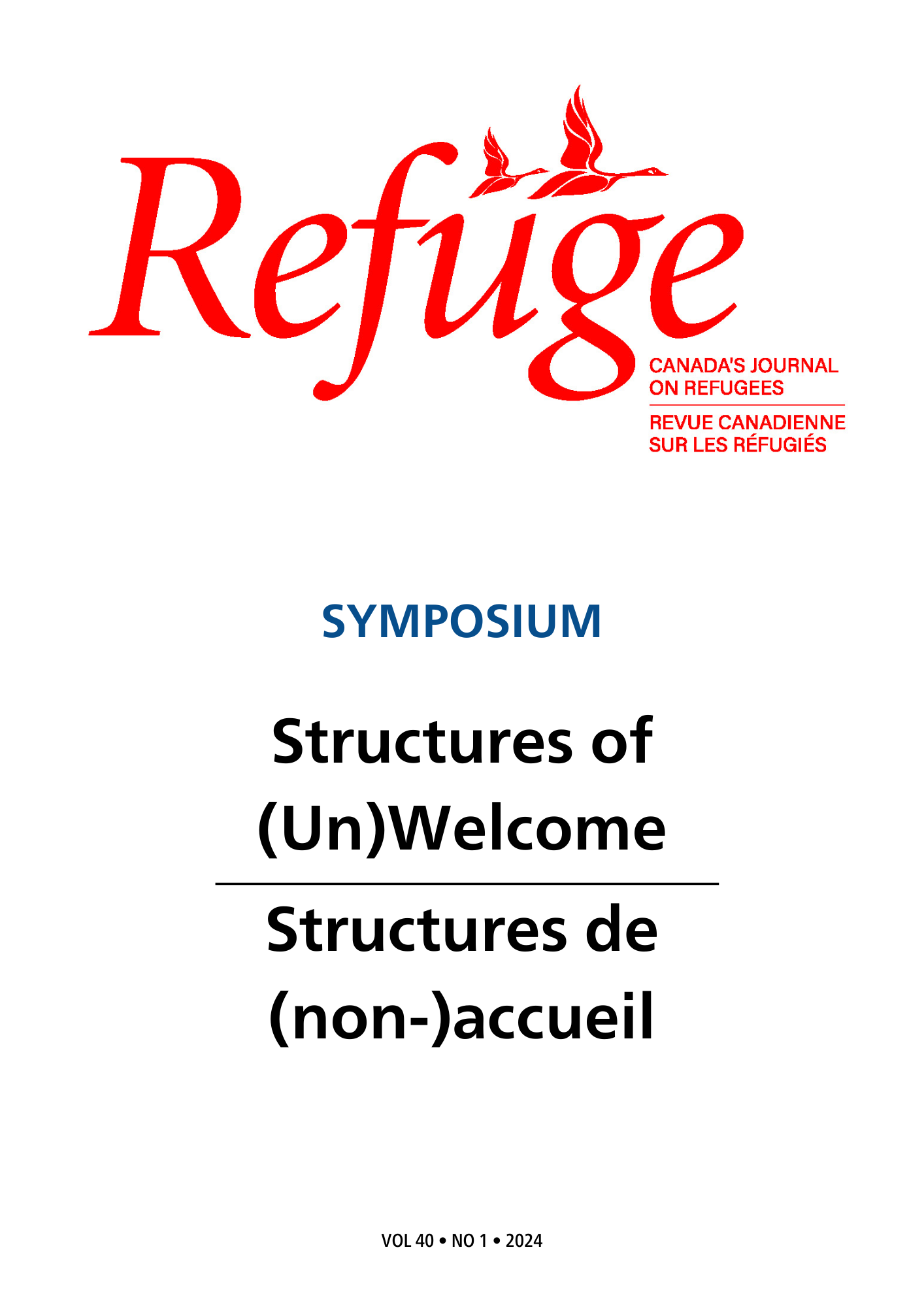Families with Refugee Backgrounds Rebuilding New Lives: A Saskatchewan Study
DOI:
https://doi.org/10.25071/1920-7336.41175Keywords:
resilience, refugees, starting over, new life, adversities, employmentAbstract
This qualitative study explores factors contributing to refugees’ resilience in Regina, Saskatchewan. It aims to add to the emerging body of Canadian literature on refugees’ strengths and experiences as they navigate resettlement in smaller urban centres. Data were collected from three focus groups that explored the experiences of 15 people from seven countries who had settled in Saskatchewan. Findings show common patterns that contributed to resilience for refugees, including pursuits of Canadian education, employment, social networks, and personal qualities. Conclusions indicate that protective factors (i.e., personal characteristics, social supports and networks, starting over in education and employment) that facilitated resilience for participants interacted and worked together to help them overcome adversity during settlement.
Metrics
References
Babatunde-Sowole, O., Jackson, D., Davidson, P. M., & Power, T. (2016). “Coming to a strange land”: The West African migrant women’s establishment of home and family in a new culture within Australia. Journal of Transcultural Nursing, 27(5), 447–455. https://doi.org/10.1177/1043659615574553
Baran, B. E., Valcea, S., Porter, T. H., & Gallagher, V. C. (2018). Survival, expectations, and employment: An inquiry of refugees and immigrants to the United States. Journal of Vocational Behavior, 105, 102–115. https://doi.org/10.1016/j.jvb.2017.10.011
Bhana, A., & Bachoo, S. (2011). The determinants of family resilience among families in low- and middle-income contexts: A systematic literature review. South African Journal of Psychology, 41(2), 131–139. https://doi.org/10.1177/008124631104100202
Bonifacio, G. T., & Drolet, J. L. (2017). Introduction. In G. Tibe Bonifacio & J. L. Drolet (Eds.), Canadian perspectives on immigration in small cities (Vol. 12, pp. 1–13). Springer International Publishing. https://doi.org/10.1007/978-3-319-40424-0_1
Bui, H., & Morash, M. (2008). Immigration, masculinity, and intimate partner violence from the standpoint of domestic violence service providers and Vietnamese-origin women. Feminist Criminology, 3(3), 191–215. https://doi.org/10.1177/1557085108321500
Carlson, B. E., Cacciatore, J., & Klimek, B. (2012). A risk and resilience perspective on unaccompanied refugee minors. Social Work, 57(3), 259–269. https://doi.org/10.1093/sw/sws003
Cardoso, J. B., & Thompson, S. J. (2010). Common themes of resilience among Latino immigrant families: A systematic review of the literature. Families in Society: The Journal of Contemporary Social Services, 91(3), 257–265. https://doi.org/10.1606/1044-3894.4003
Chen, X., & Hulsbrink, E. B. (2019). Barriers to achieving “economic self-sufficiency”: The structural vulnerability experienced by refugee families in Denver, Colorado. Human Organization, 78(3), 218–229. https://doi.org/10.17730/0018-7259.78.3.218
Cheung, M. (2008). Resilience of older immigrant couples: Long-term marital satisfaction as a protective factor. Journal of Couple & Relationship Therapy, 7(1), 19–38. https://doi.org/10.1080/15332690802129697
City of Regina. (n.d.). Regina history & facts. https://www.regina.ca/about-regina/regina- history-facts/
Clarke, V., & Braun, V. (2017). Thematic analysis. The Journal of Positive Psychology, 12(3), 297–298. https://doi.org/10.1080/17439760.2016.1262613
Creswell, J. W. (2007) Qualitative inquiry and research design: Choosing among five approaches (2nd ed.). Sage Publications.
Derksen, M., & Teixeira, C. (2023). Refugees and religious institutions in a mid‐size Canadian city. Population, Space and Place, 29(5), Article e2653. https://doi.org/10.1002/psp.2653
Donato, K. M., & Ferris, E. (2020). Refugee integration in Canada, Europe, and the United States: Perspectives from research. The Annals of the American Academy of Political and Social Science, 690(1), 7–35. https://doi.org/10.1177/0002716220943169
Garcea, J., & Kikulwe, D. (2019). The liberal plan for resettling Syrian refugees in Canada: The justificatory narrative and counter-narrative. Canadian Ethnic Studies, 51(2), 87–106. https://doi.org/10.1353/ces.2019.0012
Giesbrecht, C. J., Kikulwe, D., Sato, C. L., Este, D. C., Watkinson, A. M., & Falihi, A. (2024). “I felt like I was a puppet—He’s the master, and he’s playing with my life”: Newcomer women’s experiences of intimate partner violence. Violence Against Women, 30(5), 1226–1254. https://doi.org/10.1177/10778012231158108
Government of Saskatchewan Ministry of the Economy. (2012). Saskatchewan statistical immigration report 2010 to 2012. http://publications.gov.sk.ca/documents/310/85261-sk-immigration-statistical-report-2012.pdf
Government of Saskatchewan Ministry of the Economy. (2014). Saskatchewan statistical immigration report: 2012 to 2014. http://publications.gov.sk.ca/documents/310/93353-2014%20Immigration%20Statistical%20Report%20-%20July%2020%202016.pdf
Gray, M. (2011). Back to basics: A critique of the strengths perspective in social work. Families in Society: The Journal of Contemporary Social Services, 92(1), 5–11. https://doi.org/10.1606/1044-3894.4054
Guest, G., Bunce, A., & Johnson, L. (2006). How many interviews are enough? An experiment with data saturation and variability. Field Methods, 18(1), 59–82. https://doi.org/10.1177/1525822X05279903
Guillemin, M., & Gillam, L. (2004). Ethics, reflexivity, and “ethically important moments” in research. Qualitative Inquiry, 10(2), 261–280. https://doi.org/10.1177/1077800403262360
Haugen, S. (2019). “We feel like we’re home”: The resettlement and integration of Syrian refugees in smaller and rural canadian communities. Refuge: Canada's Journal on Refugees, 35(2), 53–63. https://doi.org/10.7202/1064819ar
Haugen, S., McNally, R., & Hallstrom, L. (2023). An evaluation of policy responses to refugee resettlement in Rural Canada. Journal of Rural and Community Development, 18(2), 105–118. https://journals.brandonu.ca/jrcd/article/view/2293
Kikulwe, D., Massing, C., Halabuza, D., Giesbrecht, C., & Ghadi, N. (2017, April) Barriers to employment, education, and child-care experienced by newcomers to Regina. Regina Region Local Immigration Partnership.
Kirmayer, L. (2013). Forward. In L. Simich & L. Andermann (Eds.), Refuge and resilience: Promoting resilience and mental health among resettled refugees and forced migrants (pp. vii–ix). Springer. https://doi.org/10.1007/978-94-007-7923-5
Lam, M. (2019). Language education for newcomers in rural Canada: Needs, opportunity, and innovations. The Journal of Rural and Community Development, 14(1), 77–97. https://journals.brandonu.ca/jrcd/article/view/1596
Layne, C. M., Warren, J. Watson, P., & Shalev, A. (2007). Risk, vulnerability, resistance, and resilience: Towards an integrative model of posttraumatic adaptation. In M. J. Friedman, T. M. Kean, & P. A. Resick (Eds.), Post traumatic stress disorder: Science and practice—a comprehensive handbook (pp. 497–520). Guilford Press.
Lee, H. S., Brown, S. L., Mitchell, M. M., & Schiraldi, G. R. (2008). Correlates of resilience in the face of adversity for Korean women immigrating to the US. Journal of Immigrant and Minority Health, 10(5), 415–422. https://doi.org/10.1007/s10903-007-9104-4
Liu, J., Mansoor, Y., Johar, J., Kim, S., Sidiqi, A., & Kapoor, V. (2020). Strengths-based inquiry of resiliency factors among refugees in metro Vancouver: A comparison of newly-arrived and settled refugees. Social Science & Medicine, 263, Article 113243. https://doi.org/10.1016/j.socscimed.2020.113243
Magro, K., & Ghorayshi, P. (2010, August 6). Adult education in an urban context: Possibilities for transformative learning (PMC Working Paper Series no. WP10). Prairie Metropolis Centre. https://sites.ualberta.ca/~pcerii/WorkingPapers/Working%20papers%20from%20
June,%202009/WP10-08.pdf
Martin, A. S., Distelberg, B., Palmer, B. W., & Jeste, D. V. (2015). Development of a new multidimensional individual and interpersonal resilience measure for older adults. Aging & Mental Health, 19(1), 32–45. https://doi.org/10.1080/13607863.2014.909383
Masten, A. S., & Curtis, W. J. (2000). Integrating competence and psychopathology: Pathways toward a comprehensive science of adaptation in development. Development and Psychopathology, 12(3), 529–550. https://doi.org/10.1017/S095457940000314X
Matheson, K., Asokumar, A., & Anisman, H. (2020). Resilience: Safety in the aftermath of traumatic stressor experiences. Frontiers in Behavioral Neuroscience, 14, Article 596919. https://doi.org/10.3389/fnbeh.2020.596919
McDermott, I. E. (2016). How public libraries can help Syrian refugees. Online Searcher, 40(2), 35–37. https://www.infotoday.com/OnlineSearcher/Articles/Internet-Express/How-Public-Libraries-Can-Help-Syrian-Refugees-109501.shtml
Molloy, M., & Simeon, J. (2016). The Indochinese refugee movement and the launch of Canada’s private sponsorship program. Refuge: Canada’s Journal on Refugees, 32(2), 3–8. https://doi.org/10.25071/1920-7336.40412
Muhammedi, S. (2022). Gifts from Amin: Ugandan Asian refugees in Canada. University of Manitoba Press.
Newbold, B., Chung, K., & Hong, E. (2013). Resilience among single adult female refugees in Hamilton, Ontario. Refuge: Canada’s Journal on Refugees, 29(1), 65–74. https://doi.org/10.25071/1920-7336.37507
Palys, T. (2008). Purposive sampling. In L. M. Given (Ed.), The Sage encyclopedia of qualitative research methods (pp. 697–698). Sage Publications.
Pulvirenti, M., & Mason, G. (2011). Resilience and survival: Refugee women and violence. Current Issues in Criminal Justice, 23(1), 37–52. https://doi.org/10.1080/10345329.2011.12035908
Rutter, M. (2013). Annual research review: Resilience—Clinical implications. Journal of Child Psychology and Psychiatry, 54(4), 474–487. https://doi.org/10.1111/j.1469-7610.2012.02615.x
Sameroff, A. J., & Rosenblum, K. L. (2006). Psychosocial constraints on the development of resilience. Annals of the New York Academy of Sciences, 1094(1), 116–124. https://doi.org/10.1196/annals.1376.010
Schweitzer, R., Greenslade, J., & Kagee, A. (2007). Coping and resilience in refugees from the Sudan: A narrative account. Australian & New Zealand Journal of Psychiatry, 41(3), 282–288. https://doi.org/10.1080/00048670601172780
Simich, L., Pickren, W., Vasilevska, B., & Rouse, J. (2011). Resilience, acculturation and integration of adult migrants: Understanding cultural strengths of recent refugees. A final report to Human Resources and Skills Development Canada, Ottawa.
Sleijpen, M., June ter Heide, F. J., Mooren, T., Boeije, H. R., & Kleber, R. J. (2013). Bouncing forward of young refugees: A perspective on resilience research directions. European Journal of Psychotraumatology, 4(1), Article 20124. https://doi.org/10.3402/ejpt.v4i0.20124
Sossou, M.-A., Craig, C. D., Ogren, H., & Schnak, M. (2008). A qualitative study of resilience factors of Bosnian refugee women resettled in the southern United States. Journal of Ethnic And Cultural Diversity in Social Work, 17(4), 365–385. https://doi.org/10.1080/15313200802467908
Statistics Canada. (2022a, October 26). Immigrant population by selected places of birth, admission category and period of immigration, 2021 census. https://www12.statcan.gc.ca/census-recensement/2021/dp-pd/dv-vd/imm/index-en.cfm
Statistics Canada. (2022b, October 26). Immigrants make up the largest share of the population in over 150 years and continue to shape who we are as Canadians. The Daily. https://www150.statcan.gc.ca/n1/daily-quotidien/221026/dq221026a-eng.htm
Statistics Canada. (2023, November 15). Census of population, 2021. https://www12.statcan.gc.ca/census-recensement/2021/dp-
pd/prof/details/page.cfm?Lang=E&GENDERlist=1&STATISTIClist=1&HEADERlist=0&DGUIDlist=2021A00054706027&SearchText=regina
Svetina, M. (2014). Resilience in the context of Erikson’s theory of human development. Current Psychology, 33(3), 393–404. https://doi.org/10.1007/s12144-014-9218-5
Thomas, J. (2015). Teaching somebody to fish: Implications for immigrant-serving organizations and employment in Edmonton and Winnipeg. Canadian Ethnic Studies, 47(1), 157–177. https://doi.org/10.1353/ces.2015.0000
Tolley, E., & Young, R. (Eds). (2011). Immigrant settlement policy in Canadian municipalities. McGill-Queen’s University Press. https://www.jstor.org/stable/j.ctt7ztnd
Ungar, M. (2013). Resilience, trauma, context, and culture. Trauma, Violence, & Abuse, 14(3), 255–266. https://doi.org/10.1177/1524838013487805
UNHCR. (2000). The Kosovo refugee crisis: An independent evaluation of UNHCR’s emergency preparedness and response. https://www.unhcr.org/sites/default/files/legacy-pdf/3ba0bbeb4.pdf
UNHCR. (2022, August 18). Facts and figures by country/region. https://www.unhcr.ca/in-canada/refugee-statistics/
Vanderbilt-Adriance, E., & Shaw, D. S. (2008). Protective factors and the development of resilience in the context of neighborhood disadvantage. Journal of Abnormal Child Psychology, 36(6), 887–901. https://doi.org/10.1007/s10802-008-9220-1
Walton-Roberts, M., Veronis, L., Cullen, B., & Dam, H. (2020). Tale of three mid-sized cities: Syrian refugee resettlement and a progressive sense of place. In L. Hamilton, L. Veronis, & M. Walton-Roberts (Eds.), A national project: Syrian resettlement in Canada (pp. 243–267). McGill-Queens University Press. https://doi.org/10.2307/j.ctv176ktst
Weller, S. C., Vickers, B., Bernard, H. R., Blackburn, A. M., Borgatti, S., Gravlee, C. C., & Johnson, J. C. (2018). Open-ended interview questions and saturation. PLOS ONE, 13(6), Article e0198606. https://doi.org/10.1371/journal.pone.0198606
Wylie, L., Corrado, A. M., Edwards, N., Benlamri, M., & Murcia Monroy, D. E. (2020). Reframing resilience: Strengthening continuity of patient care to improve the mental health of immigrants and refugees. International Journal of Mental Health Nursing, 29(1), 69–79. https://doi.org/10.1111/inm.12650
Downloads
Published
How to Cite
Issue
Section
License
Copyright (c) 2024 Daniel Kikulwe, Donalda Halabuza, Teisha Williams

This work is licensed under a Creative Commons Attribution-NonCommercial 4.0 International License.
Refuge authors retain the copyright over their work, and license it to the general public under the Creative Commons Attribution-Non Commercial License International (CC BY-NC 4.0). This license allows for non-commercial use, reproduction and adaption of the material in any medium or format, with proper attribution. For general information on Creative Commons licences, visit the Creative Commons site. For the CC BY-NC 4.0 license, review the human readable summary.







